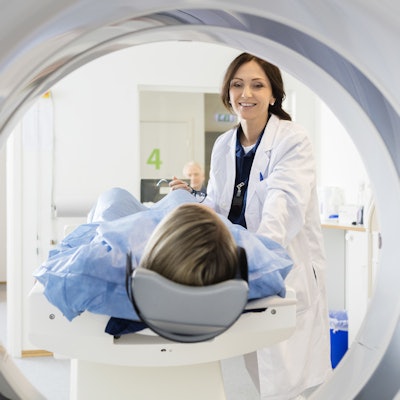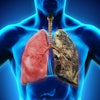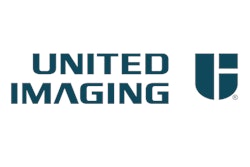
CT procedure volume has reached an all-time high in the U.S., hitting an estimated 91.4 million scans in 2019, according to a new report from IMV Medical Information Division. The pressure caused by this increased utilization has CT departments looking for ways to improve their workflow to cope with demand.
 Lorna Young of IMV Medical Information Division.
Lorna Young of IMV Medical Information Division.The new IMV report, "2019 CT Market Outlook Report," found CT volume up 3% from 88.7 million CT procedures performed in 2018. Response to IMV's survey shows the upward trend: 79% of CT sites indicated their 2019 CT patient volume increased over their 2018 volume, a 12‑percentage-point increase from 67% of the respondents in IMV's 2016 survey.
The increase has reversed a nationwide slowdown in CT procedure growth, the IMV report found. Before 2018, total CT procedures had been down from a prior peak in 2011, when 85.3 million CT procedures were performed. CT procedures had been rising at a 12% average annual growth rate from 2001 to 2011, but they then declined 5% to 80.6 million in 2012.
This apparent slowdown in total CT procedures starting in 2012 may have been influenced by the following factors:
- A change in reimbursement policy from the U.S. Centers for Medicare and Medicaid Services (CMS), which bundled certain procedures together for reimbursement purposes, such as abdomen and pelvis. Some CT departments may not have experienced a drop in the actual patient scanned, although the number of CPT-4 codes they could utilize for billing purposes was reduced.
- The growing usage of appropriate use criteria in ordering CT procedures, which were further reinforced by a change in reporting policy from the CMS. This reporting policy change mandated that under the Protecting Access to Medicare Act (PAMA) of 2014, physicians are to utilize a clinical decision support system for ordering imaging studies (CT, MR, PET, and nuclear medicine only) to assure appropriate use of imaging resources and to minimize overutilization.
However, despite these reimbursement policies, CT scanners have become an essential diagnostic tool, particularly in the emergency room. In hospitals, about half of CT procedures are conducted on an emergency basis; an additional 30% are performed on outpatients.
This increased load on CT departments to perform unscheduled CT scans in addition to their routine workload has influenced CT departments to place a high priority on managing their increased CT volume by improving department workflow and productivity and boosting staff satisfaction and morale. One hospital respondent described the impact of having to manage the department's resources differently on the department's operations: "Our emergency department is so busy that we have had to scale back our routine outpatients due to ER and inpatient loads."
Larger hospitals with 400 beds or more are meeting this workflow challenge by placing CT scanners directly in or near emergency departments, in addition to those installed in their main radiology department. Over half of these large hospitals have at least one of their CT scanners located in their emergency department.
While the majority of respondents to the IMV survey expressed optimism that their procedure volume would grow due to the increasing utility of CT imaging, over two-thirds stated that their "current CT scanner technology meets their clinical and throughput needs" and that their "current CT capacity is sufficient to meet anticipate patient volumes over the next two to three years," which may impact near-term market growth for purchasing CT scanners.
Regarding plans for acquiring CT scanners over the next three years, survey respondents stated that replacements are driving CT purchases, with about 80% of planned CT purchases replacing older units. Survey results indicate a relatively stable CT market, with 28% of all CT sites stating that they are "Yes planning" to purchase a CT scanner over the next three years, while an additional 23% stated that they are "Maybe planning." While those who "Maybe" plan to purchase CT scanners represent a less certain market potential for CT, the combined total for the sites "Yes" and "Maybe" planning has been relatively consistent at 51% to 58% since IMV's 2012 report.
For CT sites that are in buying mode, over 80% of the planned purchases of CT scanners will have configurations with 64 or more slices, and the facilities will seek advances in CT hardware and software technology to provide high-quality images while reducing the need for using contrast media in an effort to lower radiation dose, better scan obese patients, and decrease scan time. Survey respondents also indicated that they are looking for improved information technology capabilities to address CMS' requirements to put its appropriate use criteria protocol in place via electronic decision support systems, as well as to integrate cumulative radiation and contrast dose tracking into their workflow and to increase cybersecurity.
Survey participants stated that they felt the use of artificial intelligence (AI) and machine learning tools in their environment is still in its early adoption state, with only 18% of the respondents giving high "4 to 5" ratings (on a scale of 1 to 5) for the question "we will be early adopters for artificial intelligence applications using CT data for clinical decision support."
However, respondents to the IMV survey were hopeful that AI will help them with their department priorities, with the two top-ranked potential uses for artificial intelligence applications being "capabilities to improve image quality output" and "tools to help workflow from image acquisition to providing images to the radiologists."
Lorna Young is the senior director of market research at IMV Medical Information Division, part of Science and Medicine Group.
IMV's "2019 CT Market Outlook Report" explores market trends in U.S. hospitals and imaging centers, including procedure volume, manufacturer-installed base features and share, the use of OEM versus third-party service providers, purchase plans, brand loyalty, contrast utilization/budgets, CT power injectors, and site operations characteristics. The report is based on responses from 402 radiology/CT administrators who participated in IMV's nationwide survey in August-September 2019. Their responses have been projected to the IMV-identified universe of hospitals and imaging centers in the U.S. that use fixed CT scanners, and the report provides market forecast scenarios addressing the CT unit market in the U.S. for 2019-2023. Vendors covered in this report include Bayer/Medrad, Bracco Imaging, Canon/Toshiba Medical Systems, GE Healthcare, Guerbet, Hitachi Healthcare, Neusoft, Philips Healthcare, Samsung Healthcare, Siemens Healthineers, and United Imaging.
For information about purchasing IMV's "2019 CT Market Outlook Report," visit the corporate website at www.imvinfo.com or call 703-778-3080, ext. 1033, to speak with a representative.
Disclosure notice: IMV Medical Information Division is a sister company of AuntMinnie.com.



















